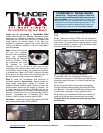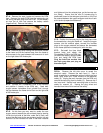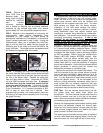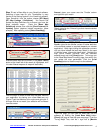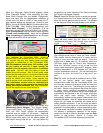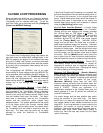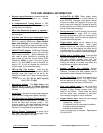
www.Thunder-Max.com 309-360 Installation / Setup Guide V2009.04.23 ProductSupport@ZippersPerformance.com
7
CLOSED LOOP PROCESSING
When equipped with AutoTune, your SmartLink software
will allow you to set Air/Fuel tuning parameters for your
ThunderMax and its installed base map. To set the
AutoTune Limits, go to the toolbar and click [Configure]
MODULE Settings].
h e
all r
[Close Loop
The Closed Loop Configuration dialog page opens; the
right side shows the default MAP settings stored in the
MAP file (settings are applied to the installed base map
during the ‘Closed Loop Format’ conversion performed
by SmartLink), while the left side shows what the module
is currently set to (unadjusted, these settings will mirror
P’s settings). MA
T e un-highlighted left ‘MODULE’ side of the pag
ows editing of those settings within the MODULE fo
tuning purposes, while unaffecting the MAP settings. To
edit module settings, click the [Link/Read (Module)]
button (left side highlights/active). You can now edit
these settings within the live module
should you want to
change any of the settings from the MAP
default
settings.
Closed Loop Processing (Module) – Check [ON] to
nable closed loop AutoTune processing. During closed
op processing, the ThunderMax module processes
edback from the oxygen sensors to adjust the fuel
olume at all points by creating learned “offset” points
om the installed ‘base map’ fuel points. The ‘static’
ase map is dynamically used by the ThunderMax
odule and the AutoTune’s active (closed loop)
edback system. This system optimizes the fuel points
fit the target air/fuel ratio through ‘learned offset
oints’. These ‘learned offset points’ are stored within
e ThunderMax and are used in conjunction with the
ase map. The ‘base map’ fuel points are not being
s occurred, to the original base map
e
lo
fe
v
fr
b
m
fe
to
p
th
b
adjusted by either the AutoTune or ThunderMax
modules.
If AutoTune Closed Loop Processing is un-checked, fuel
points will be adjusted to the last learned offset points, or
if no learning ha
points. Stored offset points remain within the module; in
the event that power is interrupted for any reason, the
learned offset points remain until re-learned or cleared
under the [Map Editing] toolbar menu.
Air Fuel Ratio Override (Module) – A single Target
AFR setting can be applied using this command.
Clicking this box and changing this number overrides
ALL ‘Air/Fuel Ratio vs. TPS’ pages at all
RPM’s. To
target specific Air/Fuel Ratio RPM ranges and throttle
positions, leave this box unchecked and edit the
individual ‘Air/Fuel-TPS @ RPM’ map pages located
under the [Tuning Maps] tree. Individual Air/Fuel
targets are pre-set within the base map to provide a
good balance between power and economy. Individual
cell throttle position/rpm AFR targets can be viewed and
adjusted on these pages. Use the left/right arrow keys
to navigate the individual blocks (strike the spacebar to
view the values); use the up/down arrow keys to adjust
the values. Click the [Monitor] button when linked live
and a vertical bar will show the actual throttle position.
See the SmartLink manual for further tuning instructions.
ldle Air Control Override (Module) - Check [OFF].
This setting should not be checked on except for
iagnosing a particular type of supported problem or
uring tuning on a load cell dyno. Changing this setting
d
d
will lead to starting and idling problems.
Maximum CLP Offset (Module) – [Session (Module)]
button sets the AFR maximum learning correction from
the base map’s fuel setting per session by percentage
(range is 0-10%). A ‘session’ is defined as the period of
time from engine on to engine off (per cycle).
[Maximum (Module)] button sets the total AFR
maximum learning correction from the base map’s fuel
setting by percentage (regardless of number of sessions;
range is 10-25%). Unless your application is a
considerable mismatch to the installed base map, the
default settings of 5 and 20 percent are sufficient for
most AFR corrections.
You should always pick the best possible map match
during the selection of your base map. The theory
behind this is to reduce the range and time the closed
loop system needs to learn offsets (corrections) for the
target AFR. If your map selection is a poor match to the
application, the amount of learning needed will be
significant. Review the parameters of your base map vs.
available base maps under ‘Base Maps Listing’ to
ensure you have the best map match and the latest
version of the map.



